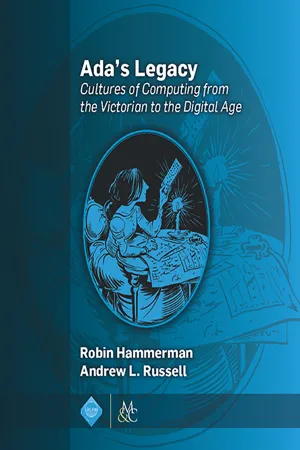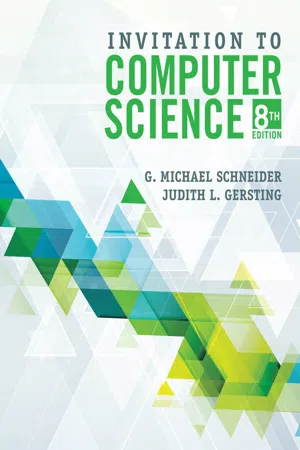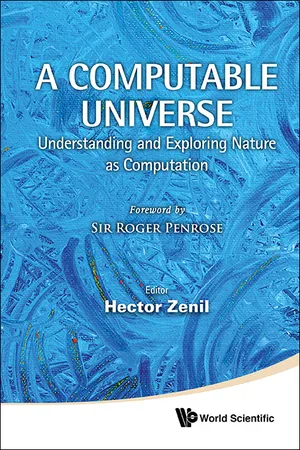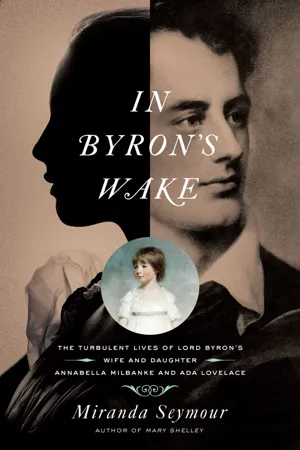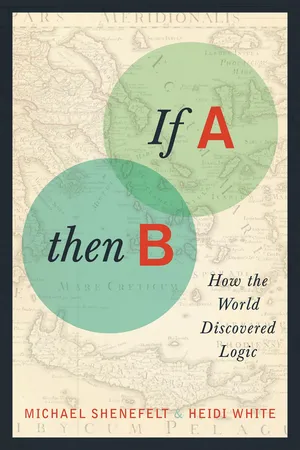Technology & Engineering
Ada Lovelace
Ada Lovelace, often regarded as the world's first computer programmer, was a mathematician and writer known for her work on Charles Babbage's early mechanical general-purpose computer, the Analytical Engine. Her notes on the engine included an algorithm for calculating Bernoulli numbers, making her a pioneer in the field of computer programming and a significant figure in the history of technology and engineering.
Written by Perlego with AI-assistance
Related key terms
1 of 5
8 Key excerpts on "Ada Lovelace"
- eBook - ePub
Ada's Legacy
Cultures of Computing from the Victorian to the Digital Age
- Robin Hammerman, Andrew L. Russell(Authors)
- 2015(Publication Date)
- ACM Books(Publisher)
PART IADA’S LEGACY IN COMPUTING
This section assesses Ada’s personal contributions to computer programming as well as the contemporary programming language that bears her name. The first two chapters provide in-depth accounts of Ada’s mathematical work, the Lovelace–Babbage collaboration in the 1830s and 1840s, and, crucially, Ada’s work with calculus and the Bernoulli numbers. The most famous—and contentious—of Ada’s mathematics comes in Note G of her translation of and commentary on Menabrea’s “Sketch of the Analytical Engine invented by Charles Babbage,” where Lovelace describes an algorithm for the computation of Bernoulli numbers. Chapters one and two provide primary and secondary sources that allow readers to revisit and reconsider the notion that Ada Lovelace was the world’s first computer programmer. Three additional chapters on the Ada programming language complete the first section. This programming language, developed in the late 20th century, carries Ada’s name but otherwise has no connection to Ada’s mathematical or scientific work—an example of Ada’s legacy moving into new and unexpected directions. In these chapters we learn about the proliferation of programming languages in the 1960s and 1970s, the community of computer scientists who worked together to define and standardize a new programming language, and the obstacles they faced in the maintenance, dissemination, and adoption of the Ada programming language. Sydney Padua’s serene image of Ada working by candlelight with punch card in hand accompanies this section. The details of activity in this image illuminate a setting and sense for developments in computing to which we are heirs.Passage contains an image
2
Charles Babbage, Ada Lovelace, and the Bernoulli Numbers
Thomas J. MisaFew figures in the long history of computing generate more passion and sometimes more enmity than Charles Babbage and Ada Lovelace. History has treated Babbage as a brilliant but temperamental pioneer in a half dozen scientific fields, an “irascible genius” in one biographer’s persisting image. Histories of mathematics typically praise his efforts to bring the modern notation of continental calculus to Cambridge University where the long shadow of Isaac Newton had reigned for more than a century. Babbage was made a Fellow of the Royal Society in 1816, just two years after leaving Cambridge. In 1820, he founded the Astronomical Society to standardize observational data and improve positional calculations. Babbage immersed himself in numerous projects and publications during the next two decades. While histories of insurance credit an early book on actuarial calculations (1826), histories of science debate his polemical On the Decline of Science (1830), histories of industry spotlight On the Economy of Machinery and Manufactures (1832), and histories of religion and science note his Ninth Bridgewater Treatise - eBook - PDF
- G.Michael Schneider, Judith Gersting(Authors)
- 2018(Publication Date)
- Cengage Learning EMEA(Publisher)
As she put it, “We may say most aptly that the Analytical Engine weaves algebraic patterns just as the Jacquard Loom weaves flowers and leaves.” Lady Lovelace worked closely with Babbage to specify how to organize instructions for the Analytical Engine to solve a particular mathematical problem. Because of that pioneering work, she is generally regarded as history’s first computer programmer. Babbage died in 1871 without realizing his dream. His work was generally forgotten until the twentieth century, when it became instrumental in moving the world into the computer age. Charles Babbage (1791–1871) Ada Augusta Byron, Countess of Lovelace (1815–1852) Copyright 2019 Cengage Learning. All Rights Reserved. May not be copied, scanned, or duplicated, in whole or in part. Due to electronic rights, some third party content may be suppressed from the eBook and/or eChapter(s). Editorial review has deemed that any suppressed content does not materially affect the overall learning experience. Cengage Learning reserves the right to remove additional content at any time if subsequent rights restrictions require it. 25 Chapter 1 An Introduction to Computer Science automatic computing machines to perform these tasks and assist the Allies in the war effort. Beginning in 1937, the U.S. Navy and IBM jointly funded a project under the direction of Professor Howard Aiken at Harvard University to build a com-puting device called Mark I. This was a general-purpose, electromechanical programmable computer that used a mix of relays, magnets, and gears to pro-cess and store data. The Mark I was the first computing device to use the base-2 binary numbering system, which we will discuss in Chapter 4. It used electro-mechanical switches and electric current to represent the two binary values, off for 0, on for 1. Until then, computing machines had used decimal representa-tion, typically using a 10-toothed gear, each tooth representing one of the digits from 0 to 9. - eBook - ePub
Computable Universe, A: Understanding And Exploring Nature As Computation
Understanding and Exploring Nature as Computation
- Hector Zenil(Author)
- 2012(Publication Date)
- WSPC(Publisher)
4 Babbage’s account is then quickly sidetracked into gearwheels and how quantity is represented by the angular displacement of toothed gears, but it is clear that the context is numerical, and that ‘analysis’ is does not conceal aspirations to greater generality. The manuscript is dated 4 May 1869. This was two-and-a-half years before Babbage’s death and so represents a mature reflection after thirty five years of Analytical Engine design. In the stated purpose of the engine there is no mention of anything outside mathematics and number, nor is there mention of anything more general in the potential of the machine.It was Lovelace who made explicit the transition from calculation to computation. She speculated that if the rules of harmony and composition were appropriately represented then the Analytical Engine ‘might compose elaborate and scientific pieces of music of any degree of complexity or extent’. She also wrote of the machine operating on numbers directly representing entities other than quantity ‘as if they were letters or any other general symbols’ and that the Analytical Engine might produce outputs in notational form.30 It seems that Lovelace saw the potential of computing in the general capacity of machines to manipulate symbols according to rules and that the power of computers lay in bridging the internal states of the machine to the world through the representational content of the symbols it was able to manipulate.Latterly Lovelace has been widely celebrated, and four main claims tend to feature in her posthumous fêting. She is variously described as a mathematics genius, as someone who made an inspirational contribution to the conception and development of Charles Babbage’s calculating engines, as being the first programmer, and, finally, she is frequently heralded as a prophet of the computer age. Of these four claims only one has credible foundation. There is no compelling evidence for the first. The second claim is readily disproved by the simple chronology of events. The third claim (that she was the first programmer) is understandable but wrong. But the tribute of being a visionary of the computer age is fully deserved and it is appropriate that she is properly celebrated. It was she who appears to have understood better than anyone the potential of computation in its more general sense.17 ,22 ,41 - eBook - PDF
Victorian Technology
Invention, Innovation, and the Rise of the Machine
- Herbert Sussman(Author)
- 2009(Publication Date)
- Praeger(Publisher)
The Living Machine 45 After years of working in private, Babbage announced his plans for the Analytical Engine publicly in 1840. He found an unexpected champion for his proposed engine in Ada, Countess of Lovelace, daughter of the poet Lord Byron. Lovelace was that most rare nineteenth-century figure, a female mathematician. Her writings publicizing the Analytical Engine illuminate Babbage’s thinking and also demonstrate that the nineteenth century real- ized that an unprecedented machine, a thinking machine, was emerging: ‘‘We are not aware of its being on record that anything partaking in the na- ture of what is so well designated the Analytical Engine has been hitherto proposed, or even thought of, as a practical possibility, any more than the idea of a thinking or of a reasoning machine.’’ 20 Lovelace emphasizes how the Analytical Engine extends the innovations of automatic textile machin- ery. She notes ‘‘how the machine can of itself, and without having recourse to the hand of man, assume the successive dispositions suited to the opera- tions’’ since the ‘‘solution of this problem has been taken from Jacquard’s apparatus … The analogy of the Analytic Engine with this well-known process [of the Jacquard] is nearly perfect.’’ 21 And in a brilliant comparison that sums up the interconnected technological innovations of the age, she neatly states, ‘‘The Analytical Engine weaves algebraic patterns just as the Jacquard loom weaves flowers and leaves.’’ 22 As public spokesperson for the Analytical Engine, Lovelace presents the Analytical Engine as a true thinking machine. She assumes that the work of the intellect itself is analogous to that of a physical machine since both oper- ate according to a set of laws or algorithms. - John Farndon(Author)
- 2010(Publication Date)
- Icon Books(Publisher)
The Difference Engine was essentially a sophisticated calculator with cogs and wheels to perform the operations; the Analytical Engine was a programmable ‘mind’ that could solve problems and learn from the solution how to solve them better in future. If it had ever been built, the Analytical Engine would have combined calculation with automation for the first time, and so created the first programmable computer. What Babbage needed was a way to programme his machine with instructions – and in the punch cards of the Jacquard loom, he realised in 1836, he had the answer. Punch cards could be used not only to control the working of his calculating machine, but to record results and calculation sequences permanently. In other words, it could be a memory.Few people grasped the significance of Babbage’s ideas. So it was with some gratitude that in 1843 he found a fan in Ada Lovelace, daughter of the poet Lord Byron. Ada was a self-proclaimed genius at maths and has been called the first computer programmer. It’s hard to say just how much she actually contributed, but she clearly grasped the significance of Babbage’s programmable ‘mechanical brain’ and its full possibilities, writing: ‘Many persons … imagine that because the Engine is to give its results in numerical notation, the nature of its processes must consequently be arithmetical and numerical … This is an error. The engine can arrange and combine its numerical quantities exactly as if they were letters or any other general symbols.’ She suggested it could ultimately be used for anything from playing chess to writing music.In the end, both Babbage’s and Ada Lovelace’s ideas had to wait another century before they became anything like reality, both because there was no real demand for such a machine, since human ‘computers’ could be hired far more cheaply to do routine calculations, and because mechanical cogs and punch cards just didn’t have the speed and accuracy needed, which was finally achieved with the electronic transistors and microprocessors that turned the computer into a reality in the mid-twentieth century.It would be wrong to give sole credit to Babbage and Lovelace for the invention of computing, or even computer programming. There were many, many people who contributed, both before and since. But the nub of the central idea in computing – the idea embodied in Babbage’s version of the punch card, the combination of automation and memory – is all there. It’s this combination that gives the computer and its spin-offs such tremendous possibilities.- eBook - ePub
- Miranda Seymour(Author)
- 2018(Publication Date)
- Pegasus Books(Publisher)
arithmetic’ had now been overstepped, Ada would write in the ‘Notes’ that formed her extended commentary on Menabrea’s report:the Analytical Engine does not occupy common ground with mere ‘calculating machines’. It holds a position wholly its own; and the considerations it suggests are most interesting in their nature ...Reading those visionary words today, it’s hard to accept that they were written a hundred years before the birth of electronic computers as we know them today.A new, a vast, and a powerful language is developed for the future use of analysis, in which to wield its truths so that these may become of more speedy and accurate practical application for the purposes of mankind than the means hitherto in our possession have rendered possible.†Composing her notes to Menabrea’s article over the early spring and summer of 1843, Ada Lovelace aimed to describe and demonstrate the importance of Babbage’s invention in clear language. As the best popular science writing still does, she used visual analogies to illustrate her points.As a mathematician, Ada had reached a level high enough to describe Babbage’s machine and discuss it with the inventor. But it is not as a mathematician that we respect her. What is remarkable about Ada Lovelace’s published ‘Notes’ – the only completed scientific writing that she appears to have produced – is the evidence they provide that, through the combination of an intuitive intelligence and her awareness of the years of discussions and planning that lay behind the unbuilt Engine, a young Victorian woman glimpsed its significance for a world that was not yet ready either for it or for her.The birth of the computer did not depend solely upon Lady Lovelace, but she unquestionably belongs to the history of that genesis. Armed with hindsight, we see how close Ada came to predicting not only the arrival of the universal computer, but the potential of technology to transform the way we function. Her perception would prove to be as suggestive and retrospectively influential as Mary Shelley’s dark vision, in 1816 (after a memorable night of storytelling in the company of Ada’s exiled father, out in a rainswept villa overlooking Lake Geneva), of the birth of bio-engineering. - eBook - PDF
Cyberspace/Cyberbodies/Cyberpunk
Cultures of Technological Embodiment
- Mike Featherstone, Roger Burrows, Mike Featherstone, Roger Burrows(Authors)
- 1996(Publication Date)
- SAGE Publications Ltd(Publisher)
I walk about, not in a Snail-Shell, but in a Molecular Laboratory' (Moore, 1977:218). Weaving Women and Cybernetics • 49 Not until the 1850s was cancer diagnosed: Lady Byron had refused to accept such news, still preferring to believe in her daughter's hysteria. Even Ada tended to the fashionable behef that over-exertion of the intellect had led to her bodily disorders; in 1844, while she was nevertheless continuing chemical and electrical experiments, she wrote; 'Many causes have contributed to produce the past derangements; & I shall in future avoid them. One ingredient, (but only one among many) has been too much Mathematics' (Moore, 1977:153^). She died in November 1852 after a year of agonized decline. Ada Lovelace often described her strange intimacy with death; it was rather the constraints of life with which she had to struggle. Ί mean to do what I mean to do she once wrote, but there is no doubt that Ada was horribly confined by the familiar - her marriage, her children and her indomitable mother conspired against her independence, and it was no wonder that she was so attracted to the unfamiliar expanses of mathematical worlds. Ada's marriage prompted the following words from her mother: 'Bid adieu to your old companion Ada Byron with all her pecuharities, caprices, and self-seeking; determined that as A.K. you will live for others' (Moore, 1977:69). But she never did. Scorning pubhc opinion, she gambled, took drugs and flirted to excess. But what she did best was computer programming. Ada Lovelace immediately saw the profound significance of the Analytical Engine, and she went to great lengths to convey the remarkable extent of its capacities in her writing. Although the Analytical Engine had its own limits, it was nevertheless a machine vastly different from the Difference Engine. As Ada Lovelace observed: The Difference Engine can in reality . - eBook - ePub
If A, Then B
How the World Discovered Logic
- Michael Shenefelt, Heidi White(Authors)
- 2013(Publication Date)
- Columbia University Press(Publisher)
As it happened, mathematicians of the period often took particular interest in machines that could do mathematical calculations. De Morgan witnessed a demonstration of Thomas Fowler’s ternary (or “three-valued”) calculating machine in 1840 and left behind a detailed description of it. He was also a friend of the mathematician and inventor Charles Babbage and of Ada Lovelace, both of whom collaborated on the plan for the “Analytical Engine,” an immense steam-powered mechanical computer that was never built. The Analytical Engine would have consisted of thousands of metal moving parts, and it might have been the size of a railroad locomotive. (Most experts today say the machine was simply impossible to construct given the technology of the age, and some have suggested that the power plant alone might have shaken the rest of the engine to pieces.) Ada Lovelace, who had been De Morgan’s student, worked out much of the theory behind the machine, and she said its inspiration came from Babbage’s earlier and more limited plan for an arithmetical calculating machine (the “Difference Engine”) and from a still-earlier invention in France of a programmable loom. Back in 1801, the French weaver Joseph Marie Jacquard had used punched pasteboard cards to control the operation of a mechanical loom that wove intricate designs in silk.As Lady Lovelace wrote in 1842, “We may say most aptly that the Analytical Engine weaves algebraical patterns just as the Jacquard-loom weaves flowers and leaves.” She calls the Analytical Engine “the material and mechanical representative” of mathematical analysis. She adds, “In enabling mechanism to combine together general symbols in successions of unlimited variety and extent, a uniting link is established between the operations of matter and the abstract mental processes of the most abstract branch of mathematical science. A new, a vast, and a powerful language is developed for the future use of analysis in which to wield its truths.”9
Index pages curate the most relevant extracts from our library of academic textbooks. They’ve been created using an in-house natural language model (NLM), each adding context and meaning to key research topics.
